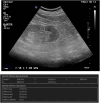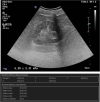Value of Shear Wave Elastography in the Evaluation of Chronic Kidney Disease
- PMID: 39669874
- PMCID: PMC11634788
- DOI: 10.2147/IJNRD.S480501
Value of Shear Wave Elastography in the Evaluation of Chronic Kidney Disease
Abstract
Purpose and motivation: Chronic kidney disease (CKD) is a major global public health problem with eventual progression to end-stage renal disease which tends to increase kidney stiffness. Shear wave elastography (SWE) is a recently developed ultrasound based technique which can be used to assess tissue stiffness noninvasively. The aim of this study was to evaluate the potential diagnostic value of SWE to assess renal parenchymal stiffness in CKD and its correlation with estimated glomerular filtration rate (eGFR), which may be used as a marker for detecting and staging CKD.
Materials and methods: The study protocol was approved by the Institutional ethics Committee at Kasturba medical college, Manipal and written informed consent was obtained from all participants. The study included 93 control subjects and 108 patients with CKD. SWE imaging was performed to assess renal cortical stiffness, as measured by the Young's modulus (YM). Correlations between SWE and conventional ultrasound parameters with age, serum creatinine, eGFR and serum urea were analysed using Pearson's correlation coefficient (p ≤ 0.05) and receiver operating characteristic (ROC) curves were derived.
Results: The diagnostic performance of SWE correlated with serum creatinine levels and eGFR. We found a statistically significant difference in kidney stiffness values between healthy individuals and CKD patients. The Spearman correlation coefficient revealed moderate negative linear correlation between the YM measurements and eGFR. We obtained a YM measurement cut-off value of 4.43 kPa, a value less than or equal to this suggested a no diseased kidney. This yielded sensitivity and specificity of 92.6% and 80.6%, respectively, with an AUROC of 0.92.
Conclusion: Our results demonstrated that shear wave elastography may provide a low-cost, non-invasive method for the morphological assessment and progression of the disease status in chronic kidney disease patients with CKD.
Keywords: chronic kidney disease; renal parenchymal stiffness; shear wave elastography.
© 2024 Lakshmana et al.
Conflict of interest statement
The authors report no conflicts of interest in this work.
Figures







References
-
- Geddes CC, Baxter GM. Renal impairment. Imaging. 2008;20(1):1–9. doi:10.1259/imaging/63493570 - DOI
LinkOut - more resources
Full Text Sources
Research Materials
Miscellaneous

